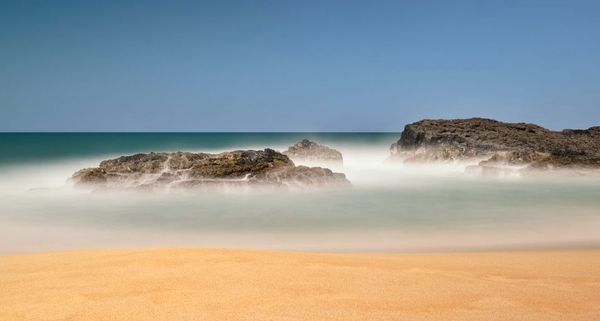Long Exposure Techniques with ND filters
Dec 20, 2014 07:53:31 #
LRNAV
Loc: Bath, Ontario. Canada
Hi ALL; I am new to the forum but am a fairly experienced photographer going back to the 1950's. That does not of course mean I am a great or even good photographer. I consider myself to be more of an enthusiast than an expert. But I am even in my mid 80's still very much a learner.
I have recently admired the the work of a Canadian photographer who works with very long exposures. His name escapes me at the moment, (that, I hope, is just a senior moment).
I have just recently bought a variable ND filter and wonder if any forum members could give me some guidance on how to best achieve those wonderful soft water and blurred cloud effects. I have 'googled' and found only very cursory or confusing advice.
Thanks
Dick K.
I have recently admired the the work of a Canadian photographer who works with very long exposures. His name escapes me at the moment, (that, I hope, is just a senior moment).
I have just recently bought a variable ND filter and wonder if any forum members could give me some guidance on how to best achieve those wonderful soft water and blurred cloud effects. I have 'googled' and found only very cursory or confusing advice.
Thanks
Dick K.
Dec 20, 2014 08:40:19 #
LRNAV wrote:
Hi ALL; I am new to the forum but am a fairly expe... (show quote)
Mt best advice for a Variable ND is DON'T USE IT! Variable ND is really two polarizers put together. One a circular polarizer and the other a linear polarizer. These ND filters are famous for the ugly X in the center of your photographs. If budget is an issue try screw on filters. If your only option is this variable ND, by all means stay away from the extreme ends of the filter.
Long exposure is the key to the results you are looking for, and what these filters are designed for. Putting a 10 stop ND on a lens to show the movement of water or clouds over a timed exposure. Be careful, shooting water you may need a regular polarizer as well as the ND
Dec 20, 2014 08:45:26 #
Capture48 wrote:
Mt best advice for a Variable ND is DON'T USE IT! ... (show quote)
I didn't make it clear, just in case you're not familiar a 10 stop filter is designed to add 10 stops of shutter to your exposure. So if your exposure was 1/2 a second, you would shoot at 480 seconds with a 3.0 ND filter. While a 0.3 filter would give you 4 second exposure. Its all a matter of the time span you want to show the movement of the clouds or water over.
Dec 20, 2014 08:57:00 #
Hi
I recently acquired at 6 stop ND filter to get those long daylight exposures that turn the water silky. For me the process has been very simple. With one glitch. With the filter attached to the lens it makes seeing through the lens to compose nearly impossible. Everything is just dark. I solved this by locking the camera on a tripod--everything locked down tight---composing the shot, then screwing the filter onto the lens. I shoot in manual so I just null the exposure by slowing the shutter until my meter shows zero and then take the shot. I have had pretty good success. Generally I take several shots at slightly different exposure so I can pick later. I'm attaching a couple of examples. If you have a specific question, please PM me. I'm only 70 and still learning like you.
The photos below at not masterpieces, I shot these while trying to learn how to use the filter. Hope they help.
Larry
I recently acquired at 6 stop ND filter to get those long daylight exposures that turn the water silky. For me the process has been very simple. With one glitch. With the filter attached to the lens it makes seeing through the lens to compose nearly impossible. Everything is just dark. I solved this by locking the camera on a tripod--everything locked down tight---composing the shot, then screwing the filter onto the lens. I shoot in manual so I just null the exposure by slowing the shutter until my meter shows zero and then take the shot. I have had pretty good success. Generally I take several shots at slightly different exposure so I can pick later. I'm attaching a couple of examples. If you have a specific question, please PM me. I'm only 70 and still learning like you.
The photos below at not masterpieces, I shot these while trying to learn how to use the filter. Hope they help.
Larry


Dec 20, 2014 09:02:02 #
LRNAV
Loc: Bath, Ontario. Canada
Thanks for the quick reply. My VND is a Bower screw on. I could have used Cokin Z filters as I use their holder for my HiTech Grad NDs, But unfortunately I left that system in my photo vest and forgot to bring it to Florida with me. (another seniors moment I guess).
Is the infamous X always present or does that depend on the lens settings and/or exposure length?
Also how do you determine exposure times My current approach is to take a test shot w/o filter, record that exposure time then multiply it for a 10 stop and reduce for lower stops by dividing by 2 for each lower stop. Will that do it?
Is the infamous X always present or does that depend on the lens settings and/or exposure length?
Also how do you determine exposure times My current approach is to take a test shot w/o filter, record that exposure time then multiply it for a 10 stop and reduce for lower stops by dividing by 2 for each lower stop. Will that do it?
Dec 20, 2014 09:04:38 #
treadwl wrote:
Hi br br I recently acquired at 6 stop ND filter ... (show quote)
I like the top photo, very nice.
That is the downside with the process for screw on filters. As you get up in stops, it's impossible to see through the lens when you recompose, you have to screw off the filter, compose your shot, and screw the filter back on.
Of course the other issue is you have to be able to calculate stops. Since your camera probably can't move past 30 seconds if your exposure is longer than that your meter won't help you. There are a ton of cheat sheets on the web, PhotoPills and other phone apps that will help with these calculations.
Dec 20, 2014 09:11:40 #
LRNAV wrote:
Thanks for the quick reply. My VND is a Bower scre... (show quote)
You may get acceptable results if you stay away from the extreme ends of these kinds of filters.
Calculating stops is not hard, I do it in my head, but today most just use an app for that. PhotoPills is a great Iphone app, there are ND Calc apps that are free for iPhone and Android and some filters like Lee provide a cheat sheet
Dec 20, 2014 09:19:38 #
Calculating f-Stops with a calculator
If the base exposure is 1/60 th of a second, and you add a 9 stop ND Filter. To calculate those nine stops divide 1 / 60 = 0.01666666667
Now multiply by 512 0.01666666667 X 512 = 8.53333333333 (seconds)
8 Stop Base Exposure 1/60 X256 =4.266666667 in seconds
9 Stop Base Exposure 1/60 X512 =8.533333333 in seconds
10 Stop Base Exposure 1/60 X1024 =17.066666 in seconds
If the base exposure is 1/60 th of a second, and you add a 9 stop ND Filter. To calculate those nine stops divide 1 / 60 = 0.01666666667
Now multiply by 512 0.01666666667 X 512 = 8.53333333333 (seconds)
8 Stop Base Exposure 1/60 X256 =4.266666667 in seconds
9 Stop Base Exposure 1/60 X512 =8.533333333 in seconds
10 Stop Base Exposure 1/60 X1024 =17.066666 in seconds
Dec 20, 2014 09:46:55 #
Because of the long exposure, you also should look at a off camera control (wired or wireless) so that pressing the shutter doesn't add vibration to the camera / tripod.
Dec 20, 2014 10:58:51 #
CHG_CANON wrote:
Because of the long exposure, you also should look at a off camera control (wired or wireless) so that pressing the shutter doesn't add vibration to the camera / tripod.
I always use a cable release---or in a pinch the self timer.
Dec 20, 2014 11:26:09 #
Leitz
Loc: Solms
[quote=Capture48]
That is the downside with the process for screw on filters. As you get up in stops, it's impossible to see through the lens when you recompose, you have to screw off the filter, compose your shot, and screw the filter back on. (quote)
Unless you just like to screw around, you only need to put the filter on once - after composing and calculating exposure.
That is the downside with the process for screw on filters. As you get up in stops, it's impossible to see through the lens when you recompose, you have to screw off the filter, compose your shot, and screw the filter back on. (quote)
Unless you just like to screw around, you only need to put the filter on once - after composing and calculating exposure.
Dec 20, 2014 11:28:57 #
Leitz
Loc: Solms
LRNAV wrote:
Thanks for the quick reply. My VND is a Bower scre... (show quote)
For times longer than 1 second, you multiply by 2.
Dec 20, 2014 11:57:57 #
LRNAV
Loc: Bath, Ontario. Canada
I think you missed my point. I was starting with a 10 stop exposure because it is easy to calculate. Divide that result by 2 for every lower stop.You are of course also right but you are starting from the other direction.
Dec 20, 2014 12:00:03 #
[quote=Leitz]
Assuming you only want to take one composition. I for one have never traveled to a location and taken only one compositional shot.
Capture48 wrote:
That is the downside with the process for screw on filters. As you get up in stops, it's impossible to see through the lens when you recompose, you have to screw off the filter, compose your shot, and screw the filter back on. (quote)
Unless you just like to screw around, you only need to put the filter on once - after composing and calculating exposure.
That is the downside with the process for screw on filters. As you get up in stops, it's impossible to see through the lens when you recompose, you have to screw off the filter, compose your shot, and screw the filter back on. (quote)
Unless you just like to screw around, you only need to put the filter on once - after composing and calculating exposure.
Assuming you only want to take one composition. I for one have never traveled to a location and taken only one compositional shot.
Dec 20, 2014 13:10:09 #
Leitz
Loc: Solms
LRNAV wrote:
I think you missed my point. I was starting with a 10 stop exposure because it is easy to calculate. Divide that result by 2 for every lower stop.You are of course also right but you are starting from the other direction.
Your calculation was correct down to 1 second, incorrect for longer times.
If you want to reply, then register here. Registration is free and your account is created instantly, so you can post right away.


